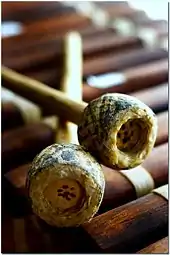Fujara
The fujara (Slovak pronunciation: [ˈfujaɾa])[1] originated in central Slovakia as a large sophisticated folk shepherd's overtone fipple flute of unique design. It is technically a contrabass in the tabor pipe class.
 | |
| Classification | Woodwind |
|---|---|
| Related instruments | |
Ranging from 160 to 200 cm long (5'3" – 6'6")[2] and tuned in A, G, or F. It has three tone holes (also called finger holes) located on the lower part of the main body. The sound is produced by a fipple at the upper end of the main body of the fujara. The air is led to the fipple through a smaller parallel pipe, called vzduchovod in Slovak (meaning "air channel"), mounted on the main body of the instrument. While it is possible to play the fundamental frequency on fujaras,[3] the normal playing technique is based on overblowing the instrument. Because of the high aspect ratio of the sound chamber (great length versus small internal diameter), the player can use overtones to play a diatonic scale using only the three tone holes. The fujara is typically played while standing, with the instrument held vertically and usually braced against the right thigh.
Technique and role

The atypical design produces a deep, meditative timbre. Ornaments are traditionally added to the base melodies, which usually occur in the mixolydian mode. Two common types of ornaments are prefuk, the rapid overblowing of a single note, from the Slovak: prefukovať, to overblow; and rozfuk, a descending cascade of overtones, from the Slovak: rozfúkať, to scatter.
Traditionally, the fujara was played by shepherds for recreation. Today, the fujara has moved from the shepherds' fields to the stage of folk festivals in the Slovak towns of Východná and Detva. The instrument has also left Slovakia and is played all over the world; particularly by aficionados of native flutes in Western Europe and North America. Despite this, the Fujara has yet to gain popularity or much recognition outside of Slovakia. Most often the fujara is a solo instrument, but ensembles of two or three fujaras have been known to exist, such as the Kubinec family or the Javorová Húžva trio.
The fujara was proclaimed in the UNESCO list of Masterpieces of the Oral and Intangible Heritage of Humanity in 2005.[4] "The Fujara and its Music" was inscribed on the Representative List of the Intangible Cultural Heritage of Humanity in 2008 by UNESCO.[2]
See also
- Koncovka another Slovak overtone flute with a fipple and no side toneholes
- Tabor pipe other 3-hole folk flutes
- Willow flute another overtone based folk flute with a side blown fipple and no side toneholes
- Kalyuka, Russian overtone flute with an end-blown open tube with no side toneholes
References
- The ad hoc pronunciation in the UNESCO video, /fuːˈdʒɑːrɑː/, is incorrect.
- "The Fujara and its Music": Description, Slideshow, Video, UNESCO, 2005, 2008. (Accessed 2012-08-12)
- "Fujara fingering technique". Retrieved 2006-09-28.
- Smeets, Rieks (2006). "The Fujara and its Music". Masterpieces of the Oral and Intangible Heritage of Humanity (PDF). UNESCO. p. 86. Retrieved 2008-07-01.
UNESCO has also provided a web page showing information about the Fujara, but it "has no official status":- Minasyan, Anahit (2006-03-24). "Proclamation 2005: "The Fujara and its Music"". Slovakia - Information related to Intangible Cultural Heritage. UNESCO. Retrieved 2008-07-01.
Further reading
- Eischek, Oskár (2006). Fujara: The Slovak Queen of European Flutes. Bratislava: Hudobné centrum. ISBN 978-80-88884-91-0.
- Garnett, Rod (2004). Flutes of Slovakia: fujara, koncovka, šesťdierková píšťalka and dvojačka. Laramie, Wyoming: University of Wyoming. pp. 8–10. OCLC 55993856.
- Rychlik, Bohuslav (Bob); American Musical Instrument Society (May 27, 2010). Folk Music from the Slovak Mountains: Lecture/Demonstration of the Fujara and Other Overtone Flutes. Benjamin Botkin Folklife Lecture Series. Thomas Jefferson Building: American Folklife Center.
- Malatinec, Roman; Danihel, Igor; Elschek, Oskár; Garaj, Bernard; Dauko, Miroslav Ruttkay (2004). Fujara – musical instrument and its music (PDF). Bratislava: Pro Musica.
External links
| Look up fujara in Wiktionary, the free dictionary. |
- www.Fujara.sk Fujjara samples
- www.Fujaraflutes.com Fujara samples
- www.tradicnepistaly.sk Fujara and other traditional Slovak instruments
- www.youtube.com/watch?v=5Y5fonktBzQ Demonstration of fujara and koncovka
- www.Fujara.ru Video and audio
| Wikimedia Commons has media related to Fujara. |

